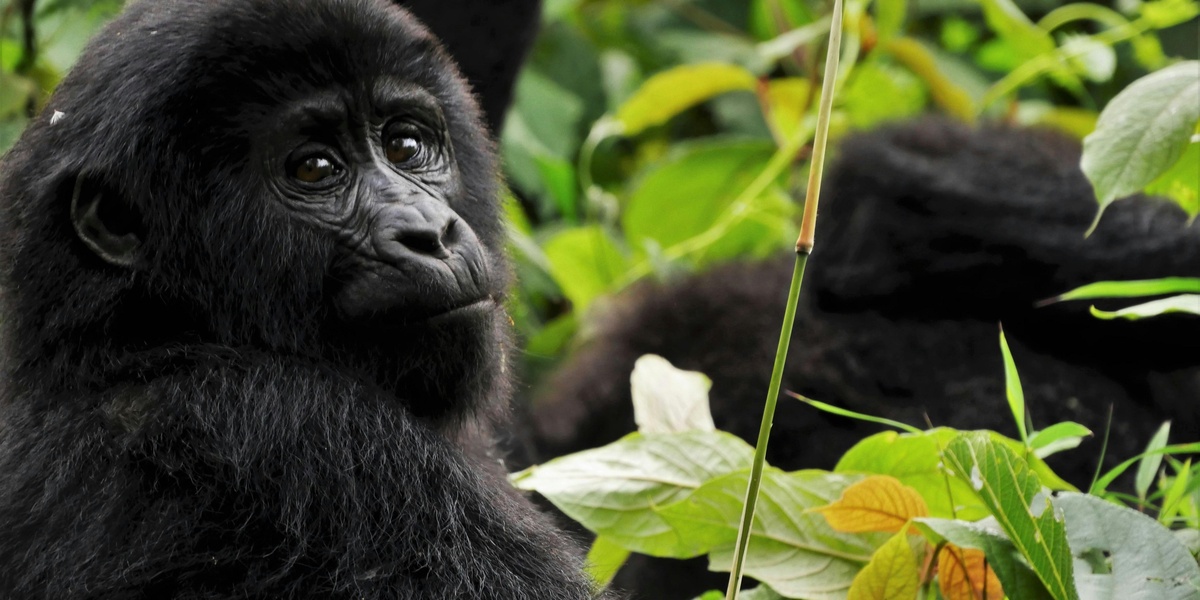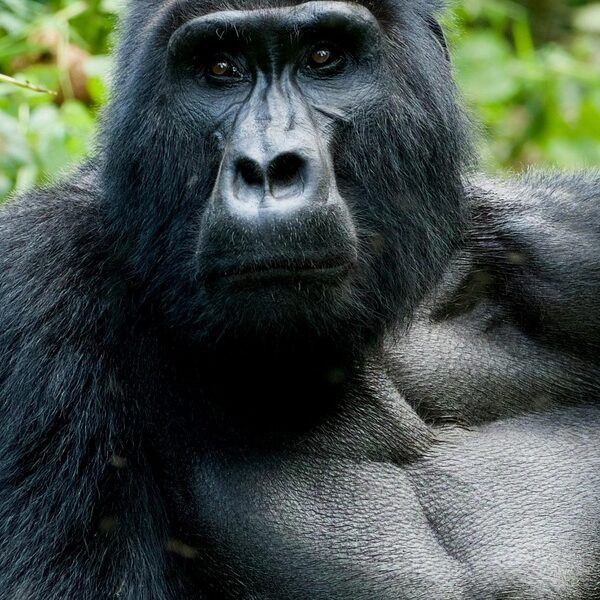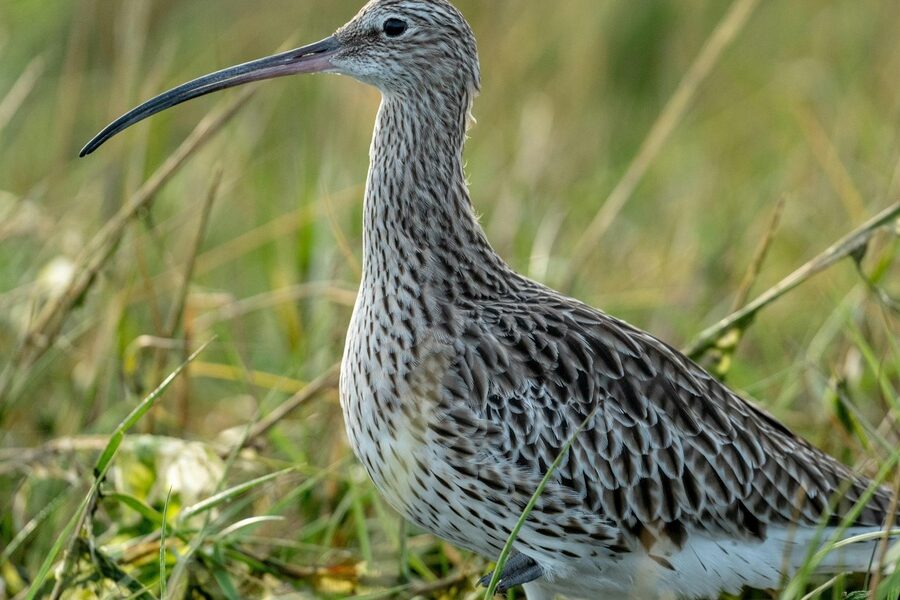The Congo Basin shelters a vast, wet tropical landscape where dense canopy and winding rivers support a wide array of mammals, birds, amphibians and invertebrates. This list aims to give a clear, usable snapshot of the animals that shape those ecosystems across core forest and fringe habitats.
There are 49 congo rainforest fauna, ranging from African Forest Buffalo to Yellow-backed Duiker. For each species, you’ll find Scientific name,IUCN status,Range & habitat — information organized for quick reference you’ll find below.
Which species in the Congo rainforest should conservationists watch first?
Focus on species with small ranges, specialized habitat needs, or heavy hunting pressure; these often show up as Vulnerable, Endangered, or Critically Endangered on the IUCN list. Use the IUCN status and Range & habitat columns here to prioritize action, and cross-check with local surveys and law-enforcement reports for up-to-date threats.
How can I use this list for field identification or research planning?
Use Scientific name to avoid confusion between common names, consult the Range & habitat column to narrow likely sightings, and check IUCN status to set research or protection priorities. Treat this list as a starting checklist and combine it with regional field guides and recent studies for on-the-ground work.
Congo Rainforest Fauna
| Common name | Scientific name | IUCN status | Range & habitat |
|---|---|---|---|
| African Forest Elephant | Loxodonta cyclotis | CR | Congo Basin countries; dense tropical rainforests |
| Western Lowland Gorilla | Gorilla gorilla gorilla | CR | Cameroon, CAR, Congo, Gabon; lowland forests |
| Bonobo | Pan paniscus | EN | South of the Congo River in DRC; humid forests |
| Chimpanzee | Pan troglodytes | EN | Across equatorial Africa; Congo Basin rainforests and savannas |
| Okapi | Okapia johnstoni | EN | Endemic to Ituri Forest, DRC; dense rainforest |
| Slender-snouted Crocodile | Mecistops cataphractus | CR | West and Central Africa; forested rivers and lakes |
| Giant Pangolin | Smutsia gigantea | EN | Equatorial Africa; rainforests and woodlands |
| Grey Parrot | Psittacus erithacus | EN | Central African rainforests; lowland forests |
| Goliath Frog | Conraua goliath | EN | Cameroon and Equatorial Guinea; fast-flowing rainforest rivers |
| Home’s Hinge-back Tortoise | Kinixys homeana | EN | West and Central Africa; tropical rainforest floors |
| Mandrill | Mandrillus sphinx | VU | Cameroon, Gabon, Congo; tropical rainforests |
| Leopard | Panthera pardus | VU | Widespread in Africa; highly adaptable in Congo rainforests |
| African Golden Cat | Caracal aurata | VU | West and Central African rainforests; dense, moist forests |
| Dwarf Crocodile | Osteolaemus tetraspis | VU | West and Central Africa; rainforest swamps and slow rivers |
| Shoebill | Balaeniceps rex | VU | Freshwater swamps of central tropical Africa; papyrus swamps |
| Congo Peafowl | Afropavo congensis | VU | Endemic to Congo Basin, DRC; lowland rainforest |
| Bongo | Tragelaphus eurycerus | NT | Central African rainforests; dense forest with undergrowth |
| African Forest Buffalo | Syncerus caffer nanus | NT | Congo Basin; dense forests and swamps |
| Yellow-backed Duiker | Cephalophus silvicultor | NT | Central and West Africa; forests and clearings |
| Congo Clawless Otter | Aonyx congicus | NT | Congo Basin; rainforest rivers and streams |
| Red River Hog | Potamochoerus porcus | LC | West and Central African rainforests; forests, swamps |
| Giant Forest Hog | Hylochoerus meinertzhageni | LC | Equatorial Africa; forest and forest-savanna mosaic |
| Water Chevrotain | Hyemoschus aquaticus | LC | Central African rainforests; near water in dense forest |
| Allen’s Swamp Monkey | Allenopithecus nigroviridis | LC | Congo Basin (Congo, DRC); swamp forests |
| Angolan Colobus | Colobus angolensis | LC | Congo Basin and East Africa; rainforests and woodlands |
| Potto | Perodicticus potto | LC | Tropical African rainforests; forest canopy |
| Blue Duiker | Philantomba monticola | LC | Central, Southern, and East Africa; forest and dense bush |
| Brush-tailed Porcupine | Atherurus africanus | LC | West and Central African forests; rainforests |
| Great Blue Turaco | Corythaeola cristata | LC | Central African rainforest belt; canopy of forests |
| Black-casqued Hornbill | Ceratogymna atrata | LC | Central African rainforests; primary forest |
| African Pitta | Pitta angolensis | LC | Breeds in Central Africa; woodland and thickets |
| Congo Serpent Eagle | Circaetus spectabilis | LC | Central African rainforest belt; dense forests |
| Bare-cheeked Trogon | Apaloderma aequatoriale | LC | Central African rainforest; middle-story of primary forest |
| Gabon Woodpecker | Dendropicos gabonensis | LC | Central African rainforest; lowland and montane forest |
| Gaboon Viper | Bitis gabonica | LC | West and Central African rainforests; forest floors |
| Rhinoceros Viper | Bitis nasicornis | LC | West and Central African rainforests; swamps and forests |
| Forest Cobra | Naja melanoleuca | LC | Widespread in Africa; forests and woodlands near water |
| Jameson’s Mamba | Dendroaspis jamesoni | LC | Central Africa; rainforests and woodlands |
| Nile Monitor | Varanus niloticus | LC | Widespread in Africa; rivers and wetlands in forests |
| Hairy Frog | Trichobatrachus robustus | LC | Central Africa; fast-flowing rivers in forests |
| Goliath Tigerfish | Hydrocynus goliath | LC | Congo River Basin; large, fast-flowing rivers |
| Elephantnose Fish | Gnathonemus petersii | LC | West and Central Africa; slow-moving, muddy rivers |
| Congo Tetra | Phenacogrammus interruptus | LC | Congo River Basin; streams and tributaries |
| African Lungfish | Protopterus aethiopicus | LC | East and Central Africa; swamps, floodplains of the Congo River |
| Congo Puffer | Tetraodon miurus | DD | Congo River Basin; sandy and muddy river bottoms |
| African Giant Swallowtail | Papilio antimachus | DD | Central African rainforests; dense forest |
| Congo Martin | Riparia congica | DD | Endemic to Congo River; sandbanks along the river |
| Goliath Beetle | Goliathus goliatus | NE | Central African rainforests; tropical forests |
| Driver Ant | Dorylus sp. | NE | Central and East Africa; rainforest floor |
Images and Descriptions

African Forest Elephant
Smaller than its savanna cousin, with straighter tusks. A critical “gardener of the forest,” it disperses seeds over vast distances. Severely threatened by ivory poaching and habitat fragmentation.

Western Lowland Gorilla
One of two western gorilla subspecies. Lives in family groups led by a silverback. Critically endangered due to poaching, disease like Ebola, and widespread habitat loss from logging and agriculture.
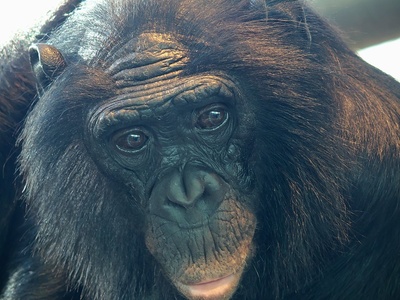
Bonobo
A great ape closely related to chimpanzees, known for its peaceful, female-dominant, and highly social society. They often resolve conflicts with complex social behaviors instead of aggression.
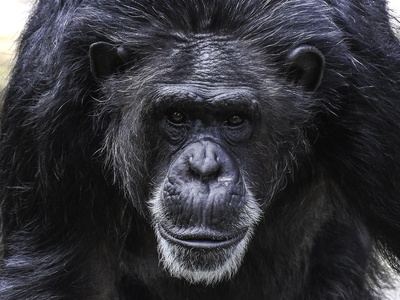
Chimpanzee
Our closest living relative, known for tool use, complex social structures, and vocal communication. Congo populations are severely threatened by the bushmeat trade, disease, and ongoing deforestation.

Okapi
The “forest giraffe,” its striped hindquarters provide superb camouflage. A solitary and elusive herbivore, it uses its long, prehensile tongue to strip leaves from branches. Threatened by poaching.

Slender-snouted Crocodile
A critically endangered crocodile distinguished by its very long, slender snout, ideal for catching fish. Its populations have plummeted due to hunting for its skin and meat, and habitat loss.
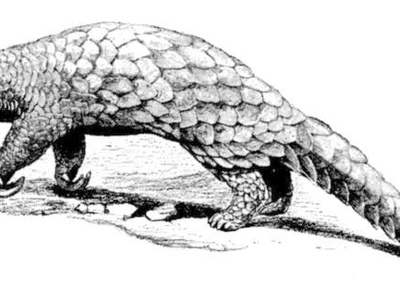
Giant Pangolin
The largest of all pangolin species, covered in protective keratin scales. This nocturnal insectivore uses its long, sticky tongue to eat ants and termites. Heavily trafficked for its scales and meat.

Grey Parrot
Renowned for its remarkable intelligence and ability to mimic human speech. These highly social birds are severely threatened by the illegal pet trade and deforestation of their nesting trees.

Goliath Frog
The world’s largest living frog, growing up to 32 cm and weighing over 3 kg. A powerful jumper, it is threatened by hunting for food and degradation of its riverine habitat.
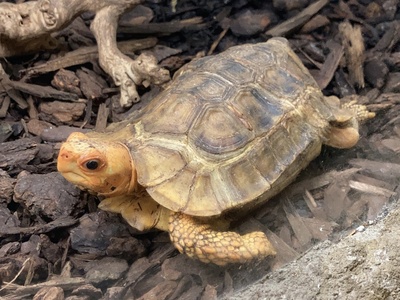
Home’s Hinge-back Tortoise
This tortoise has a unique hinge on its upper shell that closes to protect its hind legs from predators. It is threatened by habitat loss and collection for the pet trade.

Mandrill
The world’s largest monkey, famous for the male’s vibrant red and blue facial coloration. They live in massive, complex social groups called hordes and forage on the forest floor.

Leopard
A powerful and stealthy big cat with a rosette-patterned coat. An opportunistic hunter, it preys on a wide variety of animals and often hauls kills into trees to keep them safe.
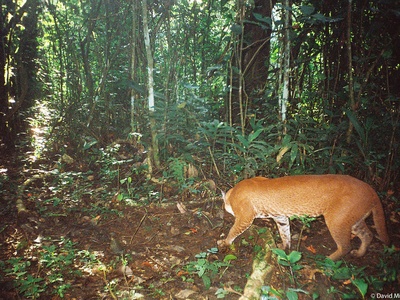
African Golden Cat
A medium-sized wild cat, closely related to the caracal. It is notoriously elusive and rarely seen. Its coat color varies from reddish-brown to grey. Threatened by deforestation and bushmeat hunting.
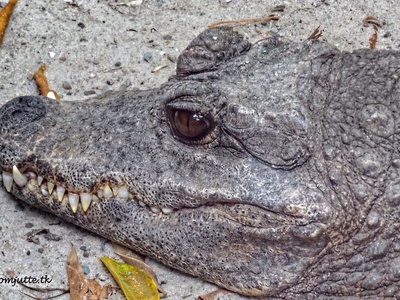
Dwarf Crocodile
The world’s smallest crocodile species, rarely exceeding 1.5 meters. It is a nocturnal, heavily armored reptile that preys on fish, crustaceans, and small mammals near the water’s edge.
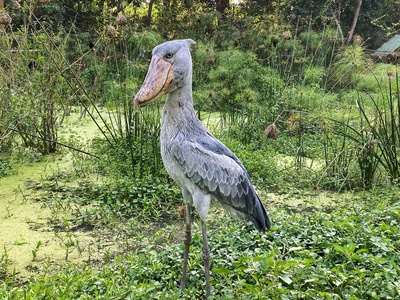
Shoebill
A large, prehistoric-looking bird named for its massive, shoe-shaped bill. A patient ambush predator, it stands motionless for hours to hunt lungfish and other fish in large swamps.
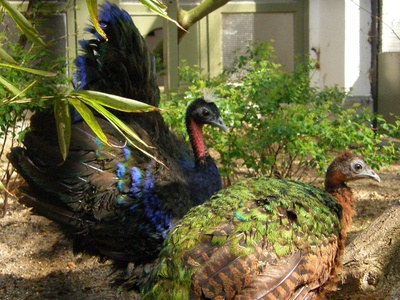
Congo Peafowl
Africa’s only true peafowl, it was unknown to science until 1936. The male has deep blue plumage and a distinctive crest. This elusive bird is the national bird of the DRC.

Bongo
A large, striking forest antelope with a bright chestnut coat, white stripes, and long, spiraled horns. These shy, nocturnal browsers are threatened by hunting and habitat loss.
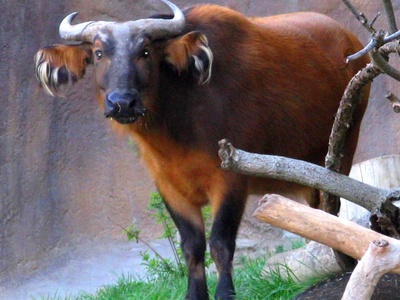
African Forest Buffalo
The smallest buffalo subspecies, with a reddish-brown coat and backward-curving horns. It lives in smaller herds than savanna buffalo and is known for its unpredictable, aggressive behavior.
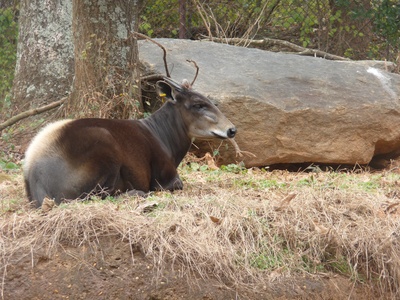
Yellow-backed Duiker
The largest duiker species, recognized by the prominent yellow patch on its rump that bristles when threatened. This shy forest antelope is primarily a fruit and foliage eater.
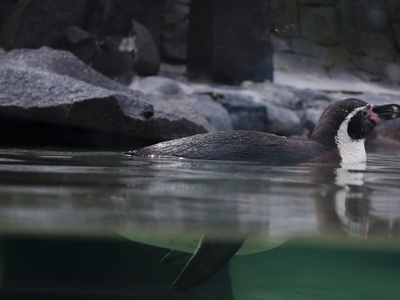
Congo Clawless Otter
A large otter with partially webbed feet and no claws on its front paws. It uses its sensitive fingers to find prey like crabs, mollusks, and frogs in muddy riverbeds.

Red River Hog
A vividly colored wild pig with a reddish coat, white dorsal stripe, and long ear tufts. They are social animals, living in groups and using their snouts to root for food.

Giant Forest Hog
The world’s largest wild pig, with males weighing up to 275 kg. They have coarse black hair and large facial warts. They are social animals that browse and graze in groups.
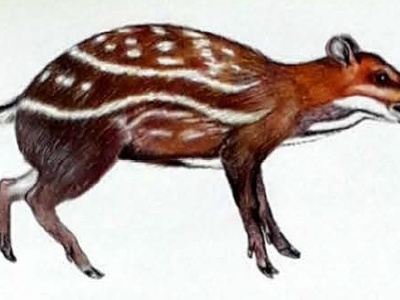
Water Chevrotain
Also known as the fanged deer, this small, nocturnal ungulate is ancient and primitive. It lacks antlers but has large canines. It dives into water to escape predators.

Allen’s Swamp Monkey
A stout monkey with webbed fingers and toes, adapted for a semi-aquatic life in swamp forests. It often forages in or near water for snails, fish, and aquatic plants.
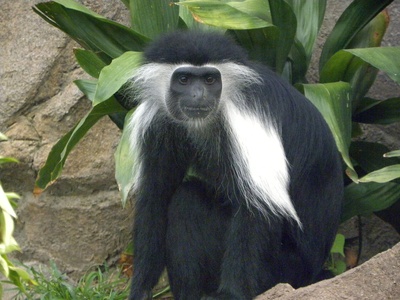
Angolan Colobus
A striking black-and-white monkey with a long, flowing white mantle of hair and a tufted white tail. It is a leaf-eater, living high in the forest canopy in small social groups.

Potto
A nocturnal primate related to lorises. Known for its slow, deliberate movements and a unique “vertebral shield” on its neck used for defense. It primarily eats fruit and insects.

Blue Duiker
One of the smallest antelope species, standing only about 35 cm tall. Its name comes from the bluish sheen of its coat. A shy browser that feeds on leaves, fruit, and flowers.

Brush-tailed Porcupine
A nocturnal rodent covered in sharp quills. It has a distinctive tuft of bristles on its tail, which it can rattle as a warning. It feeds on roots, tubers, and fallen fruit.

Great Blue Turaco
The largest turaco species, with striking blue, yellow, and black plumage and a prominent crest. It moves through the canopy in noisy, sociable flocks, feeding mainly on fruit.

Black-casqued Hornbill
A large black-and-white hornbill with a massive black casque on its bill. A crucial seed disperser, it travels in noisy flocks, feeding on fruits high in the canopy.

African Pitta
A colorful but secretive ground-dwelling bird that migrates within Africa. Known for its explosive “hopping” display and a loud, distinctive call often heard at dawn and dusk.
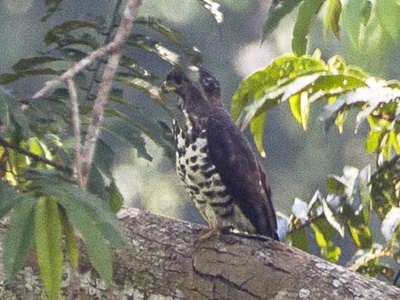
Congo Serpent Eagle
A beautiful and secretive bird of prey with a black head, a chestnut breast, and a white belly. It perches quietly inside the forest, hunting for snakes and lizards on the forest floor.
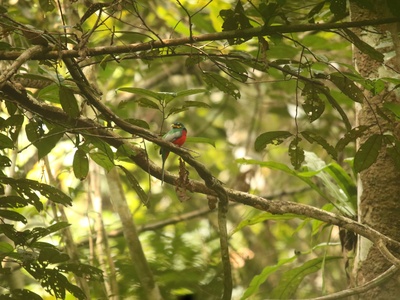
Bare-cheeked Trogon
A stunningly beautiful, quiet bird with iridescent green and blue plumage, a red belly, and patches of bare blue skin on its face. It perches motionlessly, sallying out to catch insects.

Gabon Woodpecker
A small, greenish woodpecker with a red rump and barred underparts. Like other woodpeckers, it forages on tree trunks and branches for insects, using its stiff tail feathers for support.
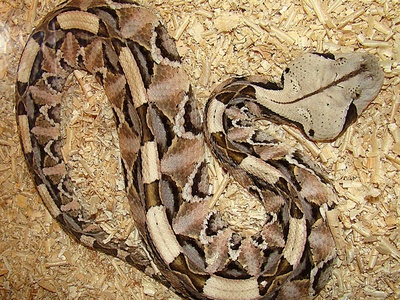
Gaboon Viper
A heavyweight venomous snake with the longest fangs of any snake (up to 5 cm). Its geometric, leaf-like pattern provides superb camouflage among the leaf litter where it ambushes prey.
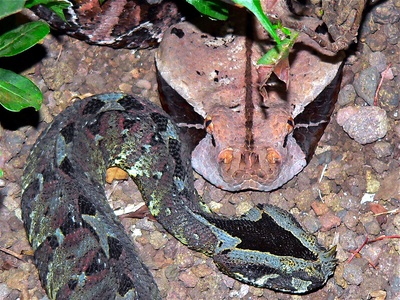
Rhinoceros Viper
A vividly colored venomous snake with a pair of prominent “horns” on its snout. Like its cousin the Gaboon viper, it is a master of camouflage, ambushing prey on the forest floor.

Forest Cobra
One of Africa’s largest and most formidable cobras, often exceeding 2.5 meters. It is an excellent swimmer and climber, preying on fish, frogs, and small mammals. Highly venomous.

Jameson’s Mamba
A highly venomous, arboreal snake that is slender and typically green or yellowish-green. It is an agile climber and active daytime hunter, preying on birds, bats, and rodents in the trees.

Nile Monitor
Africa’s largest lizard, a powerful predator and scavenger that can reach over 2 meters long. It is an excellent swimmer and climber, feeding on anything it can overpower.

Hairy Frog
Also known as the horror frog, breeding males develop hair-like dermal papillae. When threatened, it can actively break its own toe bones, pushing them through the skin to form sharp claws.

Goliath Tigerfish
A fearsome freshwater predator with 32 large, dagger-like teeth. It is famous for its power and aggression, known to attack animals its own size and even small crocodiles.
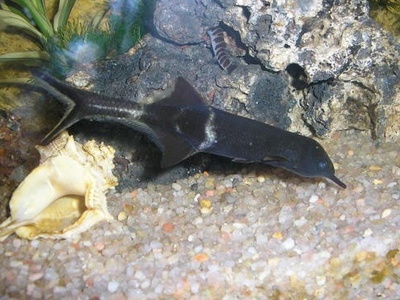
Elephantnose Fish
This odd-looking fish uses a weak electric field, generated by a special organ, to navigate and find food in dark waters. The “trunk” is actually an extension of its mouth.

Congo Tetra
A popular aquarium fish known for the male’s iridescent colors and flowing, filamented dorsal fin. In the wild, they live in large schools, feeding on small insects and crustaceans.
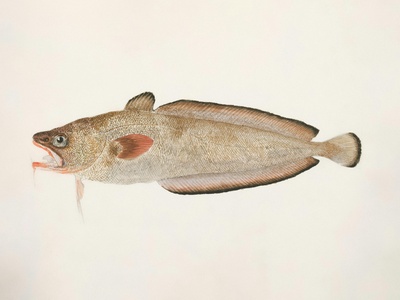
African Lungfish
An ancient fish that can breathe air using a modified swim bladder. During the dry season, it can burrow into the mud and enter a state of suspended animation (estivation).

Congo Puffer
A highly specialized freshwater pufferfish that buries itself in the substrate to ambush prey. It has a distinctive upturned mouth and can rapidly change color to match its surroundings.

African Giant Swallowtail
Africa’s largest butterfly, with a wingspan up to 23 cm. The male is highly toxic, having absorbed poisons from plants as a caterpillar, making it immune to most predators.
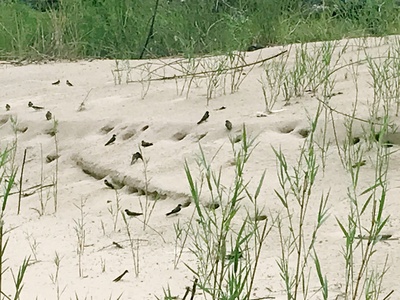
Congo Martin
A little-known swallow found only along the Congo River and its Ubangi tributary. It is a small, brownish bird that nests in colonies in sandbanks and feeds on insects over the water.
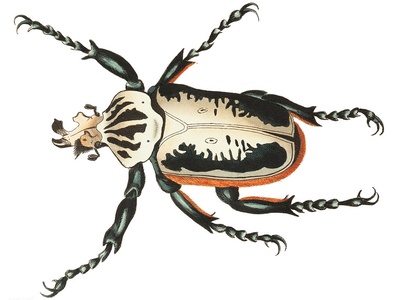
Goliath Beetle
One of the largest insects on Earth by weight and bulk. Males have a Y-shaped horn used for battles over mates and feeding sites. Larvae develop in rotting wood.
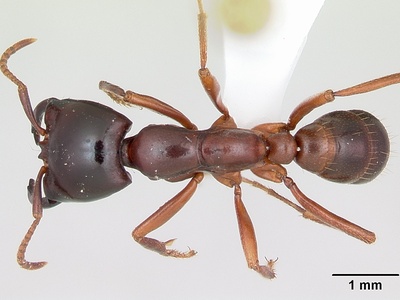
Driver Ant
A genus of army ants known for forming massive foraging columns of up to 20 million individuals. The large soldier ants have powerful mandibles, and their nomadic swarms consume almost any animal in their path.
